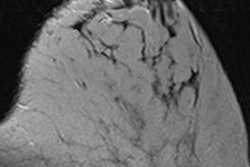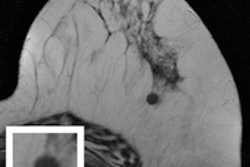Overall use of breast MRI has increased over the past decade, but there are concerns that the modality is overused in women who don't meet screening guidelines, while being underused in those who could benefit the most, according to two studies published online November 18 in JAMA Internal Medicine.
In one study, fewer than 5% of women who had more than a 20% lifetime risk of cancer received a breast MRI screening. In the second study, only 21% of women who received breast MRI met the American Cancer Society (ACS) criteria for screening, and only 48% of women with documented genetic mutations received breast MRI screening.
The significance of both studies is how "breast MRI was both overused in women not meeting guideline criteria and underused in those who could derive greatest benefit," wrote Dr. E. Shelley Hwang of Duke University Medical Center and Dr. Isabelle Bedrosian from MD Anderson Cancer Center in a commentary accompanying the articles.
"As a medical community, we bear a collective responsibility to ensure that breast MRI provides sufficient clinical benefit to warrant the additional biopsies, increased patient anxiety, and cost that accrue with its use," they wrote (JAMA Intern Medicine, November 18, 2013).
Scanning increase
In the first study, researchers from the Group Health Research Institute in Seattle collected data over a five-year period from 8,931 breast MRI exams performed on 6,777 women from five national registries in the Breast Cancer Surveillance Consortium.
Their analysis showed that utilization of breast MRI increased from 4.2 exams per 1,000 women in 2005 to 11.5 exams per 1,000 women in 2009. The greatest increase came between 2005 and 2007, with a gain of 5.8 breast MRI exams per 1,000 women per year.
(2007 was the year the ACS released its guidelines for breast MRI screening for asymptomatic women at high risk for breast cancer. The targets included women who were known BRCA gene mutation carriers, first-degree relatives of known BRCA gene mutation carriers who were themselves untested, or women with more than a 20% lifetime risk of breast cancer based on risk assessment tools and family history of breast cancer.)
Compared with women who received mammograms, those who underwent screening breast MRI were more likely to be younger than 50 years of age and white, to have never had a baby, to have a personal and family history of breast cancer, and to have extremely dense breast tissue, according to lead author Karen Wernli, PhD, and colleagues.
They also found that the most common reason for breast MRI was diagnostic evaluation of a non-MRI or clinical finding (40%), followed by screening (32%) and cancer staging and treatment (16%).
Interestingly, the proportion of breast MRI for diagnostic evaluation decreased from 53% in 2005 to 35% in 2009. Conversely, the proportion of breast MRI exams performed for screening increased from 18% in 2005 to 34% in 2009.
Wernli and colleagues could not determine if the exams for diagnostic evaluation "were performed to avoid biopsy of a suspicious clinical finding or to plan for a subsequent biopsy," they wrote. "Breast MRI to avoid biopsy does not have a sufficiently high negative predictive value to warrant its use for this purpose, particularly given the relatively low pretest probability of malignancy."
They also found that the proportion of women at high lifetime risk for breast cancer who were screened with breast MRI increased from 9% in 2005 to 29% in 2009. However, most notably, fewer than 5% of women with more than a 20% lifetime risk of cancer received breast MRI screening.
"Our findings suggest that there have been improvements in appropriate use of breast MRI, with a smaller proportion of examinations performed for further evaluation of abnormal mammogram results and symptomatic patients, and more breast MRI performed for screening of women at high risk," the authors concluded.
The study also highlighted the "need for more appropriate risk-based use of breast MRI as a screening examination because we identified women at average risk receiving MRI screening and women at high risk not receiving MRI screening," they added. "Our findings suggest that there is a need for improvement in the use of diagnostic and screening breast MRI for women most likely to benefit from this imaging tool."
Reaching a peak?
In the second study, researchers from Harvard Medical School and the Harvard Pilgrim Health Care Institute retrospectively studied 10,518 women 20 years of age and older who had at least one breast MRI in New England.
Lead author Natasha Stout, PhD, and colleagues found that breast MRI exams increased from 6.5 scans per 10,000 women in 2000 to 130.7 scans per 10,000 women in 2009. The greatest rise in breast MRI use was for screening and surveillance.
By 2011, breast MRI use had declined and then stabilized at 104.8 exams per 10,000 women. Screening and surveillance accounted for 58% of breast MRI scans by 2011; 30% of patients had a personal history of breast cancer, 52% had a family history of the disease, and 4% had a documented genetic mutation.
Among a group of women with electronic medical records who received screening or surveillance MRIs, only 21% met ACS criteria for breast MRI, whereas only 48% of those with documented genetic mutations received breast MRI screening.
"Our data suggest that the majority of women who underwent screening breast MRI did not meet the recommended criteria for appropriate use, whereas many who did meet the criteria did not undergo screening breast MRI," Stout and colleagues noted.
To better determine appropriate use, they recommended better documentation of breast cancer risk. "Understanding who is receiving breast MRI and the downstream consequences of this use should be a high research priority to ensure that the limited healthcare funds available are used wisely to maximize population health," they added.
Cost of breast MRI
"In an era of ever-increasing focus on cost containment in healthcare, the value of MRI is clearly an issue of concern," wrote Hwang and Bedrosian in their commentary.
They noted that reimbursement by the U.S. Centers for Medicare and Medicaid Services (CMS) for a digital diagnostic mammogram performed in an imaging center is approximately $300. The fee in 2013 for bilateral breast MRI with contrast ranges from $880 to $1,637.
If the estimate holds true that up to 6 million women may meet guidelines for breast MRI screening, and if even one-third of those women are screened with MRI, it could cost more than $2 billion annually for breast cancer screening alone, they wrote.



.fFmgij6Hin.png?auto=compress%2Cformat&fit=crop&h=100&q=70&w=100)




.fFmgij6Hin.png?auto=compress%2Cformat&fit=crop&h=167&q=70&w=250)











